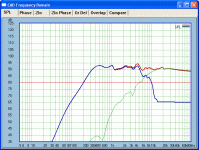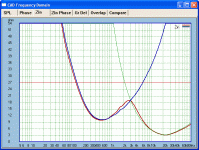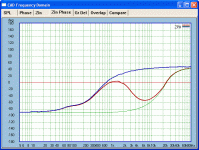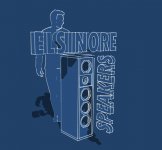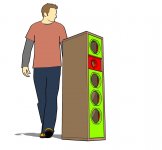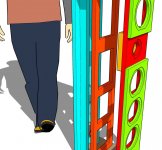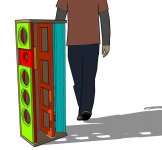otto88 said:>
To modify the earlier question, with two drivers, if a wanting to use tube amp which has say 4, 8 and 16 ohms taps, and if SPL is sufficient either way: would a tube amp more likely operate better with the two drivers wired in series or parallel?
Thanks
I think that is a matter of opinion - but tube amps ought to like higher Z and transformer's lower primary/secondary ratio at 16 Ohm.
Assuming 8 Ohm drivers, we have only 4 Ohm or 16 Ohm choice. IF you were doing it for your own use and with a tube amp with 16 Ohm tap, I'd try it. But that's me. Problem is that tube amps with 16 Ohm taps have become rare as well, usually retaining 4 and 8 taps. For commercial and other reasons you can see why 4 Ohm becomes the 'natural' choice. But what if we could get our hands on suitable 4 Ohm drivers and series them? I would try it, others wouldn't.
Cheers.
Joe R.
john k... said:
... Tolerances on T/S parameters are pretty wide. And that is only looking at the linear side of the picture. When we consider distortion we have the motor nonlinearities of one driver affecting the other. I have a design that uses dual woofers and I can clearly hear the difference....this is a dipole like application and excursions are being pushed to the limits so these nonlinearities are probably more significant in this case...
The fact too that the Elsinores have significant headroom and other series designs I've done is much the same picture. That may negate the concerns you express as they are not being "pushed to the limits" in normal use.
But if we were to do some real serious/large line sources, rarely less than 8 drivers and usually 12 and more. Again there is lots of headroom and much reduction in excursions at normal SPLs. So this seems to fit into a comfortable picture. So under those circumstances series and series/parallel options are not to be dismissed too quickly. There will be instances where they have a place.
_____________________________________
But if I may shift the topic to something that is still related and has also influenced me, but it is an issue that concern low order, specifically first. The above example I gave, with 10" Bass, 2 series connected 5" Mids plus Tweeter - 3-Way. The negative phase angle that is caused at and below the crossover frequencies is of particular concern. I shall try to expand on this.
I have to split this up and explain as I attach Gif files. So on to next post.
Please see attachment below.
This just set the picture to what follows. These are the family of responses but without the 10" Bass driver (it will cloud the argument). The mids are in series and on an open baffle. The Tweeter in the centre between the mids and it is minimum phase.
This just set the picture to what follows. These are the family of responses but without the 10" Bass driver (it will cloud the argument). The mids are in series and on an open baffle. The Tweeter in the centre between the mids and it is minimum phase.
Attachments
Blue midrange, it goes negative as it approaches the high pass frequency of the crossover, the Green tweeter does likewise. The combined plot shows both.
HIGH PASS 1ST ORDER FILTERS CREATIVE A MASSIVE PROBLEM - NEG PHASE ANGLES.
Much can be learned from studying those three sets of graphs, but it does illustrate that IF we do first order/minimum phase type of speakers, this is of particular concern. For this reason I would like to have the system Z at 8 Ohm rather than 4 Ohm - the higher Z can tolerate negative phase angles so common of low order speakers, and I am speaking as somebody who also does amplifier designs.
Now come back to the above same design, the tweeter in this case was an XT25. The system sensitivity is up around 91-92dB and the XT25 has no series resistance. The Z drops to 3 Ohm (I did not have the 8 Ohm Peerless HDS then) as the full output is needed, so only a series cap and a 500 Hz LCR trap.
Yet because of the high Z of the series mids I was able to jig things so as to make the system more amp friendly. The worst neg angle is at 6-7 Khz, yet the combined Z was high a 9 Ohm at the same freq.
(A similar picture also emerge at the lower crossover freq and its high pass filter causing the same type of problems. Crossing over to something nominally 16 Ohm mids likewise helped.)
Maybe now it is also more obvious, my enthusiasm for the 8 Ohm (nominal) Peerless HDS Tweeter. I sure could have used it here. In the Elsinores the negative phase angle is at 2KHz and is no more than -20 degrees combined with a system Z of 8-9. In the Mark 1 of the Elsinores using XT25 it was significantly worse, but even then I had to be careful and the series connection in the mids of the Elsinores helped remediate it a bit, but the HDS was much better still.
Hope I am painting a clear picture here, but for those doing sub 90dB sensitivity and high order crossovers don't have to deal with this and many who do 1st order speaker systems don't tackle it as deliberately as I do. At least that is my experience. And the dominace of 4 Ohm (many are 3 IMO) doesn't help much either, as you end up with little or zero Ohm series resistance.
But that HDS Tweeter, I love it.
So John, appreciate any comments you may have.
(And we haven't even looked at the other problem of high pass filters, the fact that it exposes Fs [Qe goes to pieces] if left alone = lots of distortion.)
Cheers.
Joe R.
HIGH PASS 1ST ORDER FILTERS CREATIVE A MASSIVE PROBLEM - NEG PHASE ANGLES.
Much can be learned from studying those three sets of graphs, but it does illustrate that IF we do first order/minimum phase type of speakers, this is of particular concern. For this reason I would like to have the system Z at 8 Ohm rather than 4 Ohm - the higher Z can tolerate negative phase angles so common of low order speakers, and I am speaking as somebody who also does amplifier designs.
Now come back to the above same design, the tweeter in this case was an XT25. The system sensitivity is up around 91-92dB and the XT25 has no series resistance. The Z drops to 3 Ohm (I did not have the 8 Ohm Peerless HDS then) as the full output is needed, so only a series cap and a 500 Hz LCR trap.
Yet because of the high Z of the series mids I was able to jig things so as to make the system more amp friendly. The worst neg angle is at 6-7 Khz, yet the combined Z was high a 9 Ohm at the same freq.
(A similar picture also emerge at the lower crossover freq and its high pass filter causing the same type of problems. Crossing over to something nominally 16 Ohm mids likewise helped.)
Maybe now it is also more obvious, my enthusiasm for the 8 Ohm (nominal) Peerless HDS Tweeter. I sure could have used it here. In the Elsinores the negative phase angle is at 2KHz and is no more than -20 degrees combined with a system Z of 8-9. In the Mark 1 of the Elsinores using XT25 it was significantly worse, but even then I had to be careful and the series connection in the mids of the Elsinores helped remediate it a bit, but the HDS was much better still.
Hope I am painting a clear picture here, but for those doing sub 90dB sensitivity and high order crossovers don't have to deal with this and many who do 1st order speaker systems don't tackle it as deliberately as I do. At least that is my experience. And the dominace of 4 Ohm (many are 3 IMO) doesn't help much either, as you end up with little or zero Ohm series resistance.
But that HDS Tweeter, I love it.
So John, appreciate any comments you may have.
(And we haven't even looked at the other problem of high pass filters, the fact that it exposes Fs [Qe goes to pieces] if left alone = lots of distortion.)
Cheers.
Joe R.
> Assuming 8 Ohm drivers, we have only 4 Ohm or 16 Ohm choice. IF you were doing it for your own use and with a tube amp with 16 Ohm tap, I'd try it. But that's me. Problem is that tube amps with 16 Ohm taps have become rare as well, usually retaining 4 and 8 taps. For commercial and other reasons you can see why 4 Ohm becomes the 'natural' choice.
But what if we could get our hands on suitable 4 Ohm drivers and series them? I would try it, others wouldn't.
Thanks, Joe
But what if we could get our hands on suitable 4 Ohm drivers and series them? I would try it, others wouldn't.
Thanks, Joe
Joe Rasmussen said:Blue midrange, it goes negative as it approaches the high pass frequency of the crossover, the Green tweeter does likewise. The combined plot shows both.
HIGH PASS 1ST ORDER FILTERS CREATIVE A MASSIVE PROBLEM - NEG PHASE ANGLES.
All high pass filters have an impedanc ephase that goes to -90 degrees in the stop band.
Red = 1st, green = 2nd, blue = 3rd, purple = 4th. Fc = 500 Hz.
Note that the higher the order the more rapid the phase changes and it asymptotes to -90 more quickly.
An externally hosted image should be here but it was not working when we last tested it.
Obviously the magnitude of the problem this creates will depend on the complete crossover design, not just the Z of the HP network. And the impact will depend on the amp used to drive the load. In any event, as you note, it's not really a problem unless the impedance is low as well.
I generally try to keep the impedance phase between +/- 30 degrees if possible, with an upper limit of +/-45. Still, I don't think impedance phase is a real problem because, for example, you could correct the phase, and make the impedance magnitrude of your speaker more uniform though the mid/tweeter x-o region by adding a conjugate network across the input terminals of the speaker as shown below. Red = with conjugate network, blue/purple = without. That's a plus regardless of amp type.
An externally hosted image should be here but it was not working when we last tested it.
Now come back to the above same design, the tweeter in this case was an XT25. The system sensitivity is up around 91-92dB and the XT25 has no series resistance. The Z drops to 3 Ohm (I did not have the 8 Ohm Peerless HDS then) as the full output is needed, so only a series cap and a 500 Hz LCR trap.
Yet because of the high Z of the series mids I was able to jig things so as to make the system more amp friendly. The worst neg angle is at 6-7 Khz, yet the combined Z was high a 9 Ohm at the same freq.
So this is really a problem resulting from the choice of tweeter.
So John, appreciate any comments you may have.
Cheers.
Joe R.
otto88 said:
To modify the earlier question, with two drivers, if a wanting to use tube amp which has say 4, 8 and 16 ohms taps, and if SPL is sufficient either way:
would a tube amp more likely operate better with the two drivers wired in series or parallel?
Thanks
Let me answer this a little differently. I would choose the format that yields the most uniform impedance for the speaker.
john k... said:
An externally hosted image should be here but it was not working when we last tested it.
Obviously the magnitude of the problem this creates will depend on the complete crossover design, not just the Z of the HP network. And the impact will depend on the amp used to drive the load. In any event, as you note, it's not really a problem unless the impedance is low as well.
That is an interesting set of plots. I have a significant overlap and more than an octave below X freq (500 Hz in your above example). It is partly because I use 1st order and also use the lower passband of the tweeter to fill in the off axis of the midrange below the X freq. This is more likely to be in the 3-5KHz range, I aim to have the tweeter to contribute to as low as 1500 Hz in some cases. Add to the fact that I don't do Butterworth filter and I sum at -6dB rather than -3dB. This -60 degrees vs -45 degrees. So I am more exposed.
I admit it freely, I have chosen this millstone myself, so I am not blaming anybody. But it does mean I have to look for solutions accordingly. But 100% vector summing I am achieving and at -6dB helps keep the tweeter's Z a bit higher, so it is not too bad. I tolerate the neg phase angle if the Z is correspondingly high.
john k... said:
I generally try to keep the impedance phase between +/- 30 degrees if possible, with an upper limit of +/-45. Still, I don't think impedance phase is a real problem because, for example, you could correct the phase, and make the impedance magnitrude of your speaker more uniform though the mid/tweeter x-o region by adding a conjugate network...
An externally hosted image should be here but it was not working when we last tested it.
Classic example you show. Let me comment on that.
I do use conjugates to help a flatter overall Z, being tube conscious, to reduce the amplitude response being modulated with tube amps that may be as high as 3 Ohm output Z.
But in my case, to suit my approach, I don't use conjugate networks in this instance when it comes to tweeters. Not that I am not saying that it may happen sometime in the future when a good reason might arise.
As your perfectly good example shows, conjugates lower/reduce the Z, they also do reduce neg phase because they draw positive current. The point I am making is that they add to the load and thus reduces Z. So the conjugate only really works beneficially when (if?) we have a high Z to play with and high Z and low phase angle coinciding at the same frequency is pretty OK already. The conjugate really neither helps nor make things worse, as I see it.
This is the rule I follow: It is where the two coincide, low Z (say four and lower) and significant neg phase angle (say well above -30) at the same frequency, this must be avoided (but conjugates are still an important tool). But coming back to the example where I used series 5" mids, it helps when they are a high 16 Ohm Z and you have that XT25 tweeter, that series element helped overcoming the XT25 by avoiding that coincidence. When phase was bad the combined Z was still above 8R. I could have use a conjugate but ended up with 4R? The improvement in the phase was offset, so no real gain. In other instances your suggestion would have to be considered.
john k... said:
So this is really a problem resulting from the choice of tweeter.
Ain't that the truth! Let's say you have an XT25 and has DCR of 2.80R and 91-92dB sensitivity. Your system sensitivity is also 91-92dB. See the problem? Add to that the approach I have take, and it's easy to see that I wrestle with this. But an 8 Ohm tweeter, DCR 5.6R (double) and 93dB sensitivity (I can even add a bit of series R), Peerless 810921, makes the job a lot more comfortable.
As I say, I've made the problems for myself, but I stand by the results I've been consistently getting and also getting tube friendly speakers to boot.
Cheers.
Joe R.
Joe Rasmussen said:That is an interesting set of plots. I have a significant overlap and more than an octave below X freq (500 Hz in your above example). It is partly because I use 1st order and also use the lower passband of the tweeter to fill in the off axis of the midrange below the X freq. This is more likely to be in the 3-5KHz range, I aim to have the tweeter to contribute to as low as 1500 Hz in some cases. Add to the fact that I don't do Butterworth filter and I sum at -6dB rather than -3dB. This -60 degrees vs -45 degrees. So I am more exposed.
I really don't know how to reply. You comment was catagorically that 1st order high pass filters were bad because they have negative (impedance) phase. My reply was that all high pass filters have negative impedance phase. It is not unique to 1st order HP filters. And I don't think it's is an issue at all. What matters is the impedance (mag and phase) of the complete speaker. The amp isn't driving the tweeter network alone.
Well that is the point. Large negative phase with higher mag Z or lower mag Z with better phase. Which does the amp prefer? I think the beneficial aspect of one vs the other is dependent on the amp used, at least if it's a tube amp.But in my case, to suit my approach, I don't use conjugate networks in this instance when it comes to tweeters. Not that I am not saying that it may happen sometime in the future when a good reason might arise.
As your perfectly good example shows, conjugates lower/reduce the Z, they also do reduce neg phase because they draw positive current. The point I am making is that they add to the load and thus reduces Z. So the conjugate only really works beneficially when (if?) we have a high Z to play with and high Z and low phase angle coinciding at the same frequency is pretty OK already. The conjugate really neither helps nor make things worse, as I see it.
This is the rule I follow: It is where the two coincide, low Z (say four and lower) and significant neg phase angle (say well above -30) at the same frequency, this must be avoided (but conjugates are still an important tool).
Well we agree that the phase isn't too important is the mag of Z is also high. But what does all this have to do with first oder HP filters? If you look at the different HP filter types you will find that actually 1st order is the least offensive. That is, if you look at the point where the phase is -60 degrees for various order HP filters, the 1st order filter has the highest impedance magnitude when thephase is -60.
As I say, I've made the problems for myself, but I stand by the results I've been consistently getting and also getting tube friendly speakers to boot.
Cheers.
Joe R.
I guess we might differ on what the definition of tube friendly is.
I'm not trying to be critical here, but I think you might look at that conjugate network. I realize it will draw more current from the amp, but assuming the amp can handle it I think it would make the speaker more "tube friendly". The network I computed was a series LRC across the input terminals of the speaker with L = 0.25 mH, C = 10uf and R = 14 ohms. Assuming that impedance curve is representative of the real speaker, you should give it a try. It all really 6 of one to 1/2 dozen of the other.
I, on the other hand, am not a low power kind of guy.
john k... said:
I really don't know how to reply. You comment was categorically that 1st order high pass filters were bad because they have negative (impedance) phase. My reply was that all high pass filters have negative impedance phase. It is not unique to 1st order HP filters. And I don't think it's is an issue at all. What matters is the impedance (mag and phase) of the complete speaker. The amp isn't driving the tweeter network alone.
Fair enough, but I was trying to paint a scenario, high sensitivity, too many good tweeters that are usually low Z that gets fully exposed because of that etc. Under those circumstances - and maybe you have to be there to experience it. Perhaps my initial comment came across a little too sweeping?
That is, if you look at the point where the phase is -60 degrees for various order HP filters, the 1st order filter has the highest impedance magnitude when thephase is -60.
That is right and I made that comment if you looked back.
> This [is] -60 degrees... But 100% vector summing I am achieving and at -6dB helps keep the tweeter's Z a bit higher, so it is not too bad.
I, on the other hand, am not a low power kind of guy.
I kinda gather that.
And that explains a lot and any differences that we may appear to have. The amps we typically use are typically 30 Watts or less and the current amps we make/sell to clients are 18 Watt (Vacuum State DPA-300B @ $16,000 built and $10,000 kit).
www.vacuumstate.com/various/dpa300B_brochure_lo-rez.pdf
And a much less expensive 20 Watt (JLTi EL34 @ $1600), also no negative feedback triode designs and hence quite high output Z.
www.customanalogue.com/jlti_el34.htm
Gotta keep the customers happy.
Joe R.
Joe Rasmussen said:
<snip>
And a much less expensive 20 Watt (JLTi EL34 @ $1600), also no negative feedback triode designs and hence quite high output Z.
www.customanalogue.com/jlti_el34.htm
Gotta keep the customers happy.
Joe R.
$18,000 for an 18 w tube amp? That's rarified air for sure! How many of those things do you sell? I must be in the wrong profession (medical manager/electrochemist).
I recall my 12 watt EICO space heater from 1958 cost ~ $79.95 as a kit...
http://cgi.ebay.com/ws/eBayISAPI.dll?ViewItem&item=140256646237
John L.
auplater said:
$18,000 for an 18 w tube amp? That's rarified air for sure! How many of those things do you sell? I must be in the wrong profession (medical manager/electrochemist).
John L.
Consider buying the kit?
The amp is pretty much designed to compete against the Audionote Kondo, have you seen what the that sells for. It's only 8W/ch.
How many DPA-300B? Not sure, the kits of parts are collected in Switzerland (they would know) and sent out to assemblers who get the fee locally for assembling, or the end user can try, but in the words of Allen Wright, it takes a skilled person to assemble, ain't no Dynakit and you have to figure out a fair bit yourself. No line by line instructions.
I use a pair for myself that is a bit less expensive and not the same flash metalwork etc. Sorta no frills version. Being a co-developer I am permitted this latitude.
But the newer JLTi EL34 has a much wider market potential, takes advantage of low Chinese costs and about the same power. It too has some unconventionality built in.
Cheers.
Joe R.
- Home
- Loudspeakers
- Multi-Way
- The "Elsinore Project" Thread
